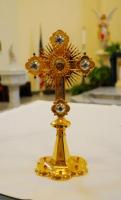A Crash Course In Relics

The veneration of saints’ relics dates back to the Church’s earliest days. Father Ryan Hilderbrand, pastor of St. Mary Parish in Huntingburg – home to many relics – elucidates the rich history of relics in the life of the Church. Father Hilderbrand notes that the early Christians only celebrated Mass at the tombs of martyrs, which reminded the faithful that martyrdom is the height of human devotion to God.
As the Church grew, the faithful sought a way to continue celebrating Mass in the presence of martyrs’ bodies while serving a greater number of people. Thus, Christians began to distribute martyrs’ remains more widely. Writing on EWTN’s website, Father William Saunders recounts that, “after Christianity became the religion of the Roman Empire, the tombs of saints were opened and the actual relics were venerated by the faithful. A bone or other bodily part was placed in a reliquary—a box, locket and later a glass case—for veneration.”
Since the fourth century, it has been a tradition to place a saint’s relic in a church’s altar stone, a practice that “keeps our ties with the ancient Church,” Father Hilderbrand said. Though this practice has not been mandatory since 1983, according to the Ceremonial of Bishops, it “should be preserved, if possible.” Relics are also often placed in reliquaries – ornate display stands that hold thecas, the small cases in which relics are protected.
Today, the Church sorts relics into three classes. First-class relics are parts of a saint’s body, including bone or flesh. Second-class relics are items worn by a saint or used by him or her, and third-class relics are objects touched to first-class relics.
Relics are distributed in two ways. If a saint belonged to a particular order, that order likely oversees the distribution of the saint’s relics. All other relics not currently in circulation are stored at and distributed from the Monastery of St. Lucy in Rome. Bishops worldwide make formal requests to receive relics for their dioceses, and nuns at the monastery process these requests and distribute relics.
Before being sent to their new homes, relics are stamped with a red wax seal and secured with a red string; to be verified as authentic, a relic must be marked with these two features and accompanied by a certificate of authenticity.


